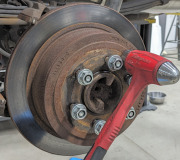Rotor thickness never caused a problem years ago. In fact, I had one rotor on a 1978 rear-wheel-drive car that was.125" under the legal limit, (not that I would ever admit to it, or do that to a customer's car), but it never caused a problem. With "improvements" in brake lining material, today the coefficient of friction changes as that material gets hotter, and the manufacturers have spent a lot of research and development on braking systems that maintain their front-to-rear balance under a variety of conditions. One of the conditions they cannot control is the difference in rotor thickness from one side to the other.
In the mid 1990's I was involved with two lemon-law trucks that had a horrendous brake pull, but only after six to eight fairly hard stops. Without warning, the next brake application resulted in a pull so hard, the truck could end up on the sidewalk or in oncoming traffic. There was a 32-page service bulletin for this problem, and the previous mechanics simply weren't aware of it. I solved both problems by following the bulletin. It involved checking for worn steering and suspension parts, checking the alignment and for matched tire sizes, verifying the control arm bushing material was the same on all parts, and the calipers were of the same design in terms of drag and piston diameter. Once all those things were ruled out, it came down to rotor thickness and speed of cut. These problems always only showed up right after a perfectly normal brake job was performed. There was one truck that had this problem before those two lemon-law trucks, and after two people working on it for a day and a half, we switched the rotors side-to-side, and the brake pull went the other way.
On the first lemon-law truck, one rotor was 0.020" thinner than the other one. In years past that would have been considered insignificant and not a topic of discussion. I used an on-car brake lathe to cut the thinner rotor just a little thinner, then I cut the fatter rotor enough to exactly match the first one. Brake pull was solved. The district representative who brought the truck to our dealership was so impressed, he brought me another one a month later. That one had only 0.007" thickness difference. That is the thickness of two sheets of paper, on a rotor that was 1 1/4" thick!
Now, you also have to consider the speed of cut on the brake lathe. Machining a rotor leaves grooves in it like on a phonograph record. A faster cut leaves wider grooves and less raised spots to contact the brake lining. More brake pedal pressure is needed to get the same stopping power, but we can't push the pedal to apply one side harder than the other. Instead, with the same pressure and different contact area, we get a brake pull. One brake heats up faster, and that changes the lining's coefficient of friction, meaning it grabs with different strength.
Those lemon-law trucks were Dodges, and the service bulletin applied to the heavier trucks, especially those with diesel engines. Within a few years we were running into the same issue with Fords and Chevrolet's. If your truck has "captive" rotors, meaning they're bolted to the back side of the wheel bearing assembly which has to be removed, you are better off finding a shop with an on-car brake lathe and having them machine both rotors right on the truck. If your rotors slide off the hub once the caliper is removed, it is pretty easy to switch them side-to-side yourself. Pulling in the other direction will verify the rotors are the cause. To solve the pull, do not just have the thicker rotor machined. Have them both machined to the same final thickness and the same speed of cut. When reinstalling them, be very careful to not contaminate the friction surfaces with any grease or chemicals, including fingerprint grease. Any contamination can be washed off with brake parts cleaner as long as the parts have not gone through a heat cycle. Once the parts get hot, any contamination will soak into the linings and the rotors, both which are porous. Then it is too late to clean them.
Tuesday, November 8th, 2016 AT 2:00 PM



